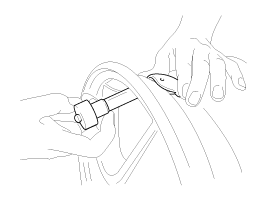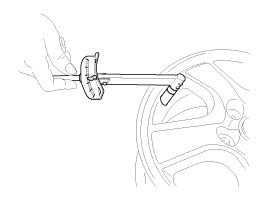 Kia Optima: Installation
Kia Optima: Installation
Sensor Fit
| Х |
Handle the sensor with
care. |
| Х |
Avoid lubricant contact. |
| Х |
Ensure that the wheel
to be fitted is designed for sensor mount. There should normally
be a mark to indicate this. |
| Х |
Ensure that the valve
hole and mating face of the wheel are clean. |
|
| 1. |
Slide the sensor-valve unit through
the valve hole of the rim. Hold the sensor against the rim and the rubber
grommet against the sealing surface. |
| 2. |
Insert the nut over the valve
stem and then tighten the nut.

|
| 3. |
Continue to tightening the nut
until contact with the rim and then tighten to 3.5 ~ 4.5Nm.

| -
|
Tighten slowly
with quarter turn steps until the final torque is reached. |
| -
|
Do not exceed
allowed torque. |
| -
|
Do not use electric
or pneumatic tools. |
|
|
| 4. |
Check that the sensor is firmly
attached to the rim.
|
Risk of damage during the tire installation/ removal if the sensor
is not firmly attached to the rim. |
|
| 5. |
Carry out inflation / pressure
correction and then fit valve cap.
|
Change the newly installed sensor mode to Normal Fixed Base(Low
Line) with the 'GDS'. Mode (Status / option) of the sensor installed
to the vehicle should be Normal Fixed Base (Low).
|
|
| 6. |
Install the tire. (Refer to "Tire
Installation") |
| 7. |
In the case of TPMS sensor failure,
TPMS sensor needs learning. Faulty sensor is replaced new units, conduct
learning of TPMS sensors. |
Repair tire after using the Tire Mobility
Kit (TMK)
When the TPMS warning lamp OFF
1.
Remove the TMK repaired tire,
wheel and TPMS sensor.(Refer to "Tire removal&quo ...
As manual for diagnosis methods by using diagnosis device, the main contents are
as follows:
1.
Connect self-diagnosis connector(16pins)
located in the lower of driver side crash pad to ...
See also:
Troubleshooting
Troubleshooting
1.
The lamp switch inputs can be
checked using the GDS.
2.
To check the input value of lamp
switch, select option "Body Control Module".
...
Securing a child restraint seat with child seat lower anchor system
Some child seat manufacturers make child restraint seats that are labeled as
LATCH or LATCH-compatible child restraint seats. LATCH stands for "Lower Anchors
and Tethers for Children". ...
Removal
1.
Disconnect the negative (-) battery
terminal.
2.
Remove the lower (A) after loosening
the mounting screws.(Refer to the BD group - "Crash pad")
...
 Kia Optima: Installation
Kia Optima: Installation Replacement
Replacement Diagnosis procedure by using diagnostic device
Diagnosis procedure by using diagnostic device

